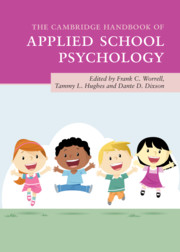Book contents
- The Cambridge Handbook of Applied School Psychology
- The Cambridge Handbook of Applied School Psychology
- Copyright page
- Contents
- Contributors
- Contributor Biographies
- Acknowledgments
- 1 Broadening the Focus of School Psychology Practice
- Part I Individual-Level Academic Interventions
- 2 Enhancing Reading Motivation in Schools
- 3 Addressing “Won’t Do” Issues in Mathematics
- 4 Learning Disabilities in Mathematics
- 5 Executive Function and School Performance
- Part II Teacher- and System-Level Interventions
- Part III Interventions from Educational and Social/Personality Psychology
- Part IV Behavioral and Social-Emotional Interventions
- Part V Health and Pediatric Interventions
- Part VI Family Connections and Life Transitions
- Part VII Special Populations
- Part VIII Conclusion
- Index
- References
3 - Addressing “Won’t Do” Issues in Mathematics
from Part I - Individual-Level Academic Interventions
Published online by Cambridge University Press: 18 September 2020
- The Cambridge Handbook of Applied School Psychology
- The Cambridge Handbook of Applied School Psychology
- Copyright page
- Contents
- Contributors
- Contributor Biographies
- Acknowledgments
- 1 Broadening the Focus of School Psychology Practice
- Part I Individual-Level Academic Interventions
- 2 Enhancing Reading Motivation in Schools
- 3 Addressing “Won’t Do” Issues in Mathematics
- 4 Learning Disabilities in Mathematics
- 5 Executive Function and School Performance
- Part II Teacher- and System-Level Interventions
- Part III Interventions from Educational and Social/Personality Psychology
- Part IV Behavioral and Social-Emotional Interventions
- Part V Health and Pediatric Interventions
- Part VI Family Connections and Life Transitions
- Part VII Special Populations
- Part VIII Conclusion
- Index
- References
Summary
To enhance math achievement, numerous instructional strategies have been and will continue to be developed. Neither typical instructional procedures nor new methods for teaching math will be successful unless students choose to engage in assigned math activities. Two factors that can influence choice are response effort and reinforcement strength. Enhancing students’ basic math fact fluency can reduce the effort required to complete simple and more complex math tasks, making it more likely that students will choose to engage in math activities. Four evidence-based procedures designed to enhance basic math fact fluency are described (i.e., Cover, Copy, and Compare; Taped Problems; Explicit Timing; and Detect, Practice, and Repair). Also, procedures designed to enhance reinforcement for choosing to engage in math tasks are reviewed. These procedures include the Additive Interspersal Procedure, altering longer assignments into multiple briefer assignments, and applying interdependent group-oriented bonus rewards.
Information
- Type
- Chapter
- Information
- The Cambridge Handbook of Applied School Psychology , pp. 30 - 47Publisher: Cambridge University PressPrint publication year: 2020
References
Enhancing Performance on In-Class Math Assignments
This article describes how classwide bonus rewards were applied in a special education classroom for middle school students with emotional/behavioral problems. In this study they increased in class math, spelling, and language arts performance.
This article describes how classwide bonus rewards were applied in a general education 1st grade classroom to increase percentage correct in class math assignments.
Enhancing Performance on Math Homework
This article describes how classwide bonus rewards were used to enhance math homework performance in four 4th-grade classrooms.
This article describes how classwide bonus rewards were applied in an 8th grade class to enhance homework assignment performance. The class included 17 students, with 10 students receiving special education services.
